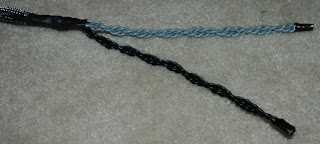 |
| Pear Anjou speaker cable |
A climax in the cable dispute may have been reached in 2007 when the skeptic James Randi offered a reward of 1 million dollars if anyone could prove that speaker cables costing $2750 for a pair of 1 meter long cables provided any improvements. He was provoked by the claims of the Pear Anjou cables shown in the image.
There was a time when connecting speakers to an amplifier was simple. Speakers came with a thin cable and that was it. This cable was very unassuming and easy to hide as shown in the image below. Then someone came along claiming that this wasn’t good enough. Neither were the tiny DIN-rated speaker plugs, even though they followed German industry standards (DIN once meant Deutsche Industrie-Normen). Since then, there has been no end to the flood of increasingly elaborate and expensive speaker cables.
 |
| Thin cable from the 1970's with DIN plugs |
Music is something that means a lot to many and it has an almost direct path into the emotions. There is therefore no doubt that what we hear and experience is what counts. But we are talking here not just about ordinary ears, but golden ears - those who through training and experience have a special ability to perceive what others cannot hear. Although it is easy to cheat in this field, there is no doubt that such golden ears exist. But they have their limitations. They are good for analyzing and spotting deficits in sound reproduction, but they provide very few clues as to what it takes to design equipment that sounds correctly.
The story about the Norwegian company Electrocompaniet illustrates the value of golden ears. In the 1970's they came up with one of the first power amplifiers that fixed what was called ‘transistor sound’. Many could hear the problem with early transistor amplifiers, but few knew what caused it before the Finnish professor Matti Ottala explained it as transient intermodulation distortion. Today it is usually called slew-induced distortion. This story demonstrates how an audible problem was not fixed until someone managed to quantify it with measurements. Read the fascinating story of Svein-Erik Børja with the golden ears, and Terje Sandstrøm with the engineering talent in British Hi-Fi News from 2011. It shows how important it is to quantify with numbers what matters to the audible impression.
 |
| A speaker cable which is too thin along with one that is better |
It is also easy to explain from measurements. It is first and foremost resistance in ohms per meter that explains it. For the thinnest cable it is 0.045 ohm/m or 0.45 ohm for a 5 m cable (back and forth). The voltage of the amplifier will be divided between the resistance of the cable and the resistance or impedance of the speaker of nominally 4 ohms. This gives a loss of 1 dB which is audible. Even more audible will be the coloration of the sound that comes from the speaker's impedance varying with frequency. It can cause both a resonant top in the bass and a raising of the treble. Another argument for low resistance is that this helps the amplifier dampen speaker motion once a signal has stopped. This is called the damping factor.
Here many with a scientific or technical background stop and reject all other arguments. My point in the rest of this article and in part two, is to discuss the main technical arguments that have been raised. The various manufacturers don't really promote their solutions solely on the basis of subjective listening impressions. Virtually everyone has arguments based on some physical principle. They like to claim that they are particularly good at this single aspect where the company believes they have a special insight. This is formulated in scientific terms. But then we are really at the heart of what this blog is all about. If it is formulated in scientific terms, it should be possible to analyze with respect to whether this aspect is important or not.
 |
| Twisted multi-conductor cable |
I have already shown the most common types of cables in the figures above. Here are two slightly more exotic types. The first is a cable made by twisting together many thinner conductors, in this case a do-it-yourself cable. It is designed to have the least possible inductance as well as to minimize the consequences of the skin effect. The latter is the tendency for alternating current only to flow in the outer part of a conductor.
 |
| Cable with large distance between the conductors (Schnerzinger) |
But what are the factors which are of real importance? In part 2, we consider those aspects, beyond resistance, which are emphasized in cable design.
References:
- Perlman, Marc. "Golden Ears and Meter Readers. The Contest for Epistemic Authority in Audiophilia." Social Studies of Science 34.5 (2004): 783-807.
- Sandstrøm, Terje. "Distortion in class AB power amplifiers." Audio Engineering Society Convention 71. Audio Engineering Society, 1982. (From his master's thesis in physics, University of Oslo)
(First published in Norwegian in: Magiske høyttalerkabler)
The post "Magical speaker cables - part 1" first appeared on the LA3ZA Radio & Electronics Blog.



No comments:
Post a Comment